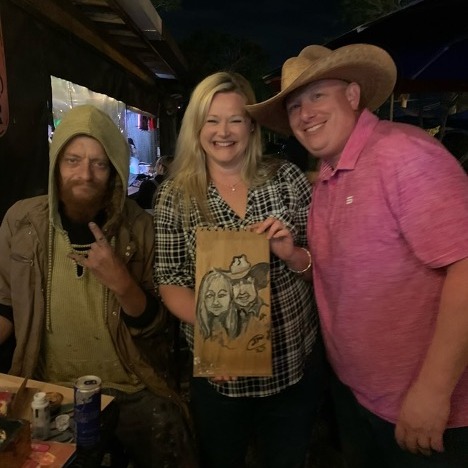Brother Frog - Food for Thought

My neighborhood has a little dive bar called Shorty’s that has karaoke every Friday night.
It’s endlessly entertaining. There are the usual off-key, missed-words kinds of performances, but they are interspersed with moments of magic. You never know when a bona-fide musician will drop by and have some fun (they often do) or an unlikely character will come up to the mic and knock everybody’s socks off. One of my favorite semi-regulars is a small, timid woman named Megan that I suspect works quietly in an office somewhere. When her name is called, she approaches reluctantly and stands with her head down waiting for her music to start. Then she blows everybody’s minds with a pitch-perfect Whitney Houston or Adele, just like in the movies.
Another unlikely character in this weekly extravaganza is a guy who goes by the name of Frog.
We first noticed him one night sitting with his back to the music, sketching images of people in the crowd. My curious artist husband was compelled to check out what he was doing and the next thing I knew, Frog was sitting at our table, and we had become his subjects. In about ten minutes, he produced a portrait of my husband and I that was pretty darn good. What was more interesting, though, was how he did it.
His canvas was a piece of plywood. His pen was a stick he’d picked up from the ground. He’d use a lighter to burn the end, draw a few strokes and then burn again. He repeated this over and over until the stick was gone and the portrait was complete. I couldn’t believe what this guy did in ten minutes with a stick, a lighter and a piece of reclaimed plywood.
Over the last few years, we’ve taken almost all our houseguests over to Friday night karaoke at Shorty’s for some cheap entertainment and a portrait by Frog. One of my favorite things about this has been seeing what Frog is using for his canvas and pen. You never know. We have portraits done on the backs of old cabinet doors, on pieces of old cardboard, even pieces of broken fencing. He uses what he can find.
What Frog is doing so beautifully is demonstrating the power of constraints.
Constraints are limits. They are the edges. The paradox of constraints is that we usually see them as barriers or problems, but creativity actually requires them.
We don’t usually like constraints. I know I don’t. I often resist spending limits or time limits or knowledge limits. They seem so, well, limiting. Turns out, though, that those limits are what enable beauty and creative things to happen.
Aza Raskin is quoted as saying “Design is the beauty of turning constraints into advantages”.
Here’s a great example: not many people know the origins of the classic Dr. Seuss book Green Eggs and Ham. Do you? Theo Geisel, who we know as Dr. Seuss, was offered a $50 bet by his publisher. The challenge was to write a children’s book using only 50 different words. The result was one of the most popular books ever published.
Instead of being a dampening force, the constraint turned into an enabler. It is what created the container for the magic to happen. I think this is Frog’s magic, too. He can’t afford expensive art supplies. Instead of preventing him from drawing, it has invited endlessly unique creations. I love our little collection.
This all came up the other day in a conversation with a client. She has an incredibly difficult boss. The boss’s behaviors and demands put a lot of stress on her team and deflate her motivation to do the things she knows she needs to do. She’s been noticing how easily she can slide into a victim mindset, using her boss’s behavior as an excuse to stop trying so hard. She had a whole list of things she wanted to do that started with the words “I can’t…”
This is the thing about constraints: they are almost always truly difficult and very real.
Frog’s lack of financial resources is real. My client’s boss does genuinely destructive things. The challenge is to transform how you see the constraint, shifting the focus from what you don’t have to what you can do.
We began to think a bit together about what she is able to do and try, about what kinds of conversations or processes this dynamic might be inviting. Her energy lit up as she began to see the constraints created by this difficult relationship in a new way. She stopped saying “I wish I could…” and started sentences with “I’m going to try…”.
Of course constraints can, and sometimes should, change. Tolerating bad behavior isn’t a long-term strategy. Learning how to use them to advantage, though, is the very essence of creativity and artistry. Sometimes the most beautiful things emerge from the worst circumstances.
What are the things you’ve been complaining about?
What could you do if you saw those things as enablers, instead of problems?
What sticks are you going to turn into paintbrushes?
Just a little food for thought.
